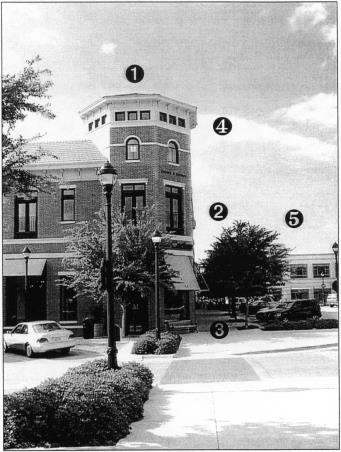Chapter 16.22
MIXED USE DISTRICT
Sections:
16.22.020 Mixed use development district.
16.22.030 Mixed use regulations.
16.22.040 Mixed use site development standards.
16.22.050 Mixed use design guidelines.
16.22.010 Purpose and intent.
A. The Mixed Use District provides opportunities for an integrated mix of residential, retail, service, civic, entertainment and office opportunities in attached or detached structures, developed as a single project or multiple related projects. The Mixed Use District also allows the flexibility to create single-use commercial or residential projects; however, these are not the preferred projects and do not receive any incentives.
The general plan outlines goals, objectives, and policies regarding the character of mixed use development, especially in the town center. The general plan provides a set of guiding principles for the town center and includes guidance to ensure vitality (e.g., activity, extended hours), diversity (e.g., wide range of services and varied scale), distinctiveness (e.g., unique theme and uses), connectivity (e.g., pedestrian and vehicular), flexibility (e.g., design and phasing), quality (e.g., architectural theme, attention to detail), and compatibility (e.g., between uses and with adjacent neighbors).
It is the purpose of this chapter to provide regulations that implement those goals, objectives and policies, assuring the availability of a wide range of mixed use opportunities.
B. It is the further intent of this chapter to:
1. Provide incentives for the development of mixed use projects;
2. Ensure the intelligent mixture of uses and a high level of design;
3. Ensure adequate light, air, privacy, security, and open space for residential uses;
4. Protect the various uses from objectionable noise, illumination, unsightliness, odors, smoke and other deleterious influences; and
5. Minimize traffic congestion and facilitate the provision of utility services and other public facilities commensurate with anticipated population, dwelling unit densities, and service requirements including transit services.
C. Town Center Mixed Use District. While the Mixed Use District allows for a range of possibilities for development, the city desires a preferred pattern of development within the town center, as conceptually shown in the community design element of the general plan. Development proposals within the Town Center Mixed Use District shall be reviewed for consistency with the intent of the preferred pattern of development.
D. A high quality of design and attention to detail are expected in the Mixed Use District. An example of the type of quality expected is shown in Illustratives 1 through 3 in HMC 16.22.050. (Ord. 307 § 30, 2006)
16.22.020 Mixed use development district.
A. Mixed Use (MU). The purpose of the Mixed Use (MU) District is to provide sites for the mixture of residential, retail, service, civic, entertainment and office uses in integrated structures or project sites. The goal of the Mixed Use (MU) District is to create unique places by providing maximum flexibility to land owners and developers.
B. The Mixed Use District provides for the development of attached mixed use structures and/or separated multiple use projects.
C. Residential Densities. The actual density which may be attained in the residential portion of a mixed use project shall be determined by the land development review process and public hearings as described in Chapters 16.04 and 16.08 HMC. The planning commission, city council, and community development director shall have the authority to reasonably condition proposed residential development to ensure that appropriate transitions are provided and that the proposed development is compatible with other uses in the mixed use project and adjacent development, both existing and proposed.
D. “Threshold densities,” as specified by the general plan, may be exceeded, up to the “maximum allowable density” for the Mixed Use District, pursuant to the provisions of HMC 16.40.090(B), Density Bonuses. (Ord. 307 § 30, 2006)
16.22.030 Mixed use regulations,
Identified on Table 16.22.030.A are those land uses or activities that may be permitted in the Mixed Use District, subject to the provisions of this chapter, this title and applicable general plan policies, and those land uses and activities that are not permitted. Table 16.22.030.A also indicates the development procedure and the approval type by which each listed land use or activity may be permitted in an attached mixed use structure or in a separated multiple use project.
A. Where the symbol “■” appears, the corresponding land use or activity is not permitted.
B. Where the symbol “P” appears, the corresponding land use or activity is permitted by right; provided, that the use is in conformance with the provisions of this title.
Permitted uses shall be subject to the consistency assessment, which shall determine the conformance of the proposed use or activity with the provisions of this title in conjunction with, and as a requirement of, the issuance of a permit by any city department.
C. Where the symbol “SR” appears, the corresponding land use or activity may be permitted subject to the approval of a staff review permit application processed in conformance with the procedures as provided for in Chapter 16.08 HMC.
D. Where the symbol “C” appears, the corresponding land use or activity may be permitted subject to the approval of a conditional use permit application processed in conformance with the procedures as provided for in Chapter 16.08 HMC.
|
Use 1 |
Attached Mixed Use Structure |
Separated Multiple Use Project |
|---|---|---|
|
A. Attached mixed use or separated multiple use projects (any two or more permitted or conditionally permitted uses) |
C |
C |
|
B. Residential uses |
|
|
|
1. Single-family detached |
■ |
SR |
|
2. Single-family attached (e.g., duplex, triplex, fourplex – not attached mixed use) |
C |
SR |
|
3. Multiple-family attached (not mixed use) |
C |
SR |
|
4. Senior independent living |
C |
C |
|
5. Senior congregate care, assisted living |
C |
C |
|
6. Convalescent care |
C |
C |
|
7. Accessory dwelling units and junior accessory dwelling units (shall comply with the provisions of HMC 16.44.180) |
P |
P |
|
C. Office and related uses |
|
|
|
1. Administrative and executive offices |
P |
P |
|
2. Artist and photographic studios, including sale of equipment or supplies |
SR |
P |
|
3. Clerical and professional offices |
P |
P |
|
4. Financial services and institutions |
P |
P |
|
5. Medical, dental and related health services for humans, including laboratories, clinics, and the sale of articles clearly incidental to the services provided |
SR |
P |
|
D. Commercial uses |
|
|
|
1. Antique shops |
P |
P |
|
2. Apparel stores (sales) |
P |
P |
|
3. Art, music, dance, photographic studios and supply stores |
SR |
P |
|
4. Athletic and health clubs |
C |
SR |
|
5. Bakeries (retail) |
SR |
P |
|
6. Barber and beauty shops |
SR |
P |
|
7. Bicycle shops (nonmotorized) |
SR |
P |
|
8. Book, gift, and stationery stores |
P |
P |
|
9. Camera shops |
P |
P |
|
10. Candle shops |
SR |
P |
|
11. Candy stores and confectioneries |
SR |
P |
|
12. Car washes (self-serve and/or automated only) |
■ |
C |
|
13. Check cashing |
C |
C |
|
14. Clothing and costume rental |
P |
P |
|
15. Cocktail lounges/bars, including upgrading an existing ABC license (e.g., beer and wine to a hard liquor license) |
C |
C |
|
16. Department stores |
P |
P |
|
17. Drapery and decorating shops |
P |
P |
|
18. Drugstores/pharmacies |
P |
P |
|
19. Extreme value retail |
C |
C |
|
20. Fast food restaurants |
SR |
SR |
|
21. Fixed price retail |
C |
C |
|
22. Floral shops |
SR |
SR |
|
23. Food stores and supermarkets |
P |
P |
|
24. General retail stores |
P |
P |
|
25. Hardware stores |
P |
P |
|
26. Hobby shops |
P |
P |
|
27. Hotels and motels |
C |
C |
|
28. Insurance services |
P |
P |
|
29. Investigation services |
P |
P |
|
30. Jewelry stores |
P |
P |
|
31. Kiosks (parking lot film processing and key shops) |
SR |
P |
|
32. Laundry pick-up and delivery agencies and self-service laundries |
SR |
SR |
|
33. Liquor stores |
SR |
SR |
|
34. Massage establishments2 |
■2 |
■2 |
|
35. Mortgage services |
P |
P |
|
36. Music stores |
P |
P |
|
37. Newspaper and magazine stores |
P |
P |
|
38. Odd-lot/close-out retail |
C |
C |
|
39. Political or philanthropic headquarters |
P |
P |
|
40. Real estate services |
P |
P |
|
41. Restaurants other than fast foods: |
SR |
SR |
|
a. With entertainment |
C |
C |
|
b. Without entertainment but with serving alcoholic beverages, including upgrading an existing ABC license (e.g., beer and wine to a hard liquor license) |
C |
C |
|
42. Shopping centers |
P |
P |
|
43. Sporting goods stores |
P |
P |
|
44. Shoe stores (sales) |
P |
P |
|
45. Stamp and coin shops |
P |
P |
|
46. Stationery stores |
P |
P |
|
47. Toy stores |
P |
P |
|
48. Travel agencies |
P |
P |
|
49. Variety stores |
P |
P |
|
50. Weight reduction centers |
P |
P |
|
E. Public/quasi-public uses |
|
|
|
1. Day nurseries, nursery schools, child care facilities, per state law |
|
|
|
a. (14 or fewer children) |
■ |
■ |
|
b. (More than 14 children) |
■ |
■ |
|
2. Post office branches |
C |
C |
|
3. Community facilities and religious institutions |
C |
C |
|
4. Clubs, lodges, fraternities/sororities |
C |
C |
|
5. Educational institutions (public and private) |
SR |
SR |
|
6. Fire and police stations |
SR |
SR |
|
7. Public libraries and museums |
SR |
SR |
|
8. Public parks and recreation |
P |
P |
|
9. Public utilities and public service substations, reservoirs, pumping plants and similar installations, not including public utility offices |
■ |
C |
|
10. Recreational facilities (e.g., country clubs, tennis and swim clubs, golf courses), including limited commercial uses which are commonly associated with and directly related to the primary use |
SR |
SR |
|
F. Home based businesses (subject to the provisions of HMC 16.44.140, and the issuance of a home based business permit) |
P |
P |
|
G. Temporary uses (subject to the provisions of HMC 16.08.120, and the issuance of a temporary use permit) |
SR |
SR |
|
H. Accessory uses |
|
|
|
1. Wireless telecommunication facilities |
|
|
|
a. Major |
■ |
C |
|
b. Minor |
SR |
SR |
|
2. Antennas, satellite dishes |
SR |
SR |
|
3. Guest quarters/second unit |
SR |
SR |
|
4. Private garages |
P |
P |
|
5. Private swimming pools, tennis courts |
P |
P |
|
6. Other accessory uses and structures located on the same site as a permitted use |
P |
P |
|
7. Other accessory uses and structures located on the same site as a use subject to a staff review permit |
SR |
SR |
|
8. Other accessory uses and structures located on the same site as a use subject to a conditional use permit |
SR |
SR |
|
I. Other uses similar to, and no more objectionable than the uses identified above, shall be reviewed per the process required by the similar use, as determined by the planning commission. |
|
|
1 Uses that are not listed and not reasonably similar to a listed use are prohibited.
2 Massage services may be performed in a beauty shop, nail salon, or day spa where massage services account for less than 30 percent of the gross square footage of the business and when conducted in accordance with the requirements of Chapter 5.16 HMC.
Legend
■ Not permitted.
P Permitted subject to consistency assessment.
SR Permitted subject to approval of a staff review permit application.
C Permitted subject to approval of a conditional use permit application.
E. Special Use Regulations.
1. Animals. It is the general intent of the city to permit the keeping of animals without the creation of a nuisance to surrounding residents and visitors. Animals that may be kept within a residential portion of a separated multiple use project are identified in HMC 16.44.040. Animals not listed in said section may be permitted in residences subject to city review and confirmation that a nuisance condition will not be created.
All animals, excluding household pets, shall be kept a minimum distance of 50 feet from any street; 20 feet from any property line; and 40 feet from any adjacent dwelling, school, hospital or church located on any adjoining site. The location of corrals, fenced enclosures, barns, stables or other enclosures used to confine horses shall conform to this requirement. (Ord. 448 § 7, 2021; Ord. 427 § 7, 2018; Ord. 394 §§ 9, 17, 2014; Ord. 307 § 30, 2006)
16.22.040 Mixed use site development standards.
A. General Requirements. Table 16.22.040.A describes the minimum site development standards applicable to proposed and existing development in the Mixed Use District. Given that there are numerous variations of land use within the Mixed Use District, the characteristic of the proposed development shall dictate the applicable standards. For instance, a project with commercial on the bottom floor and residential above is subject to the requirements noted for attached mixed use structures. All development shall conform to the standards established in this section.
1. In addition to the minimum standards established in Table 16.22.040.A, developments within the Mixed Use Districts shall also comply with the special requirements contained in subsection B of this section, Chapter 16.48 HMC, Performance Standards, other applicable city ordinances, and the city’s general plan.
|
Requirement |
MU |
|---|---|
|
Attached Mixed Use Structures (integration of commercial/office and residential into a single structure) |
|
|
1. Maximum residential density (DUs per gross acre) |
18 |
|
2. Maximum nonresidential intensity (F.A.R.) |
1.0 |
|
3. Minimum building site (net area in sq. ft.) |
None |
|
4. Minimum lot width |
None |
|
5. Minimum lot depth |
None |
|
6. Minimum front yard setback |
0 ft. if public plaza of at least 400 square ft. and a minimum dimension of 15 ft. in each direction provided in front yard |
|
|
5 ft. if no public plaza provided in front yard |
|
7. Minimum interior side yard setback |
None if adjacent to commercial or office uses |
|
|
If adjacent to residential uses, then 10 ft. if 2 stories or less, and 15 ft. if 3 or more stories |
|
8. Minimum street side yard setback |
None |
|
9. Minimum rear yard setback |
None if adjacent to commercial or office uses |
|
|
If adjacent to residential uses, then 10 ft. if 2 stories or less, and 15 ft. if 3 or more stories |
|
10. Maximum lot coverage |
100% |
|
11. Maximum height |
65 ft. for habitable space |
|
|
70 ft. for architectural features such as clock towers, spires, or corner features |
|
12. Minimum dwelling unit size in square feet |
One-bedroom = 600 sq. ft. |
|
|
Two-bedroom = 800 sq. ft. |
|
|
Three-bedroom = 1,000 sq. ft. |
|
13. Parking |
Parking standards are per the provisions of HMC Chapter 16.52. Shared parking will be allowed in lieu of satisfying parking requirements for each use per approval by the community development director subsequent to a shared parking study |
|
Separated Multiple Use Projects (unattached multiple uses, such as commercial and residential, developed in a single project)1 |
|
|
1. Maximum residential density (DUs per gross acre) |
18 |
|
2. Maximum nonresidential intensity (F.A.R.) |
0.5 |
|
3. Minimum building site (net area in sq. ft.) |
|
|
a. Detached residential |
4,000 |
|
b. Attached residential |
10,000 |
|
c. Commercial/office |
10,000 |
|
4. Minimum lot width |
|
|
a. Detached residential |
50 ft. |
|
b. Attached residential |
80 ft. |
|
c. Commercial/office |
80 ft. |
|
5. Minimum lot depth |
|
|
a. Detached residential |
80 ft. |
|
b. Attached residential |
100 ft. |
|
c. Commercial/office |
100 ft. |
|
6. Minimum front yard setback |
|
|
a. Detached residential |
10 ft. |
|
|
5 ft. for unenclosed porch |
|
b. Attached residential |
15 ft. average |
|
|
10 ft. minimum |
|
c. Commercial/office |
20 ft. average |
|
|
15 ft. minimum |
|
7. Minimum interior side yard setback |
|
|
a. Detached residential |
5 ft. |
|
b. Attached residential |
15 ft. if adjacent to commercial |
|
|
If adjacent to residential uses, then 10 ft. if 2 stories or less, and 15 ft. if 3 or more stories |
|
c. Commercial/office |
None if adjacent to commercial |
|
|
15 ft. if adjacent to residential |
|
8. Minimum street side yard setback |
|
|
a. Detached residential |
10 ft. |
|
b. Attached residential |
15 ft. |
|
c. Commercial/office |
20 ft. |
|
9. Minimum rear yard setback |
|
|
a. Detached residential |
15 ft. |
|
b. Attached residential |
If adjacent to residential uses, then 10 ft. if 2 stories or less, and 15 ft. if 3 or more stories |
|
c. Commercial/office |
If adjacent to residential uses, then 15 ft. if 2 stories or less, and 20 ft. if 3 or more stories |
|
10. Maximum lot coverage |
|
|
a. Detached residential |
40% |
|
b. Attached residential |
50% |
|
c. Commercial/office |
NA |
|
11. Maximum height |
|
|
a. Detached and attached residential |
35 ft. or 2-1/2 stories, whichever is greater |
|
b. Commercial/office |
35 ft. if adjacent to residential uses, otherwise 60 ft. |
|
12. Minimum dwelling unit size in square feet |
One-bedroom = 800 sq. ft. |
|
|
Two-bedroom = 1,000 sq. ft. |
|
|
Three-bedroom = 1,200 sq. ft. |
|
|
Four-bedroom = 1,400 sq. ft. |
|
13. Minimum distance between buildings (including main dwellings and accessory structures) |
10 ft. |
|
14. Parking |
Parking standards are per the provisions of Chapter 16.52 HMC. Shared parking will be allowed in lieu of satisfying parking requirements for each use per approval by the community development director subsequent to a shared parking study |
|
Single Use Projects (projects that are either all residential or all commercial/office) |
|
|
1. Residential only projects |
Comply with the R-3 development standards (Chapter 16.16 HMC) |
|
2. Commercial/office only projects |
Comply with the NC development standards (Chapter 16.20 HMC) |
1. Attached mixed use structures shall be subject to the development standards identified for “Attached Mixed Use Structures” in Table 16.22.040.A, even when adjacent to or when proposed within one project containing “Separated Multiple Use” development or “Single Use” development.
B. Special Development Standards.
1. Air conditioners, heating, cooling, ventilating, pool, spa or sauna equipment and all other mechanical, lighting or electrical devices shall be so operated that they do not disturb the peace, quiet and comfort of neighboring residents and shall be screened from surrounding properties and streets. Additionally, no such equipment, with the exception of ground-mounted air conditioning, shall be located in the required front yard setback, street side yard setback, or closer than the building setback to any residential dwelling on adjacent properties. All equipment shall be installed and operated in accordance with all other applicable city ordinances and shall be subject to approval by the community development director prior to installation.
2. In separated multiple use projects, the required front and street side yards shall be landscaped and shall consist predominantly of drought-tolerant plant materials except for necessary walks, drives and fences and provided with an automatic underground irrigation system.
3. In attached mixed use projects, the front and street side yards may include both hardscape and drought-tolerant plant materials and provided with an automatic underground irrigation system.
4. Parking.
a. In attached mixed use projects, parking for any residences of the project shall be secured and separated from public parking. Residential parking shall be accessed by a separate and secured entrance. One parking space for each four dwelling units shall be provided for guest parking. Guest parking spaces shall be distributed throughout the site. Such guest parking areas shall be conveniently located and may be uncovered.
b. In separated multiple use projects, assigned parking shall be provided within 150 feet of the front entrance of the dwelling unit for which it serves. Each dwelling unit shall be provided with two parking spaces within a fully enclosed garage. Guest parking spaces shall be distributed throughout the site. Such guest parking areas shall be conveniently located and may be uncovered.
c. All parking spaces shall maintain a minimum inside dimension of 10 feet in width and 20 feet in length.
d. On-street parking shall not be used to satisfy any of the above parking requirements.
e. Automatic garage door openers shall be required for each garage.
f. Tandem parking shall not be permitted except when used for residential parking in structures that include both residential and nonresidential uses and when the tandem spaces do not exceed 25 percent of the residential parking spaces and are at a minimum 12 feet wide.
5. Provisions for Residential Uses.
a. Within for-sale projects, separate utility services shall be provided to each dwelling unit.
b. Each dwelling unit shall be provided with a minimum of 200 cubic feet of secure exterior storage space.
c. All permanent mechanical equipment, such as motors, compressors, pumps, and compactors, which are determined by the building official to be a source of structural vibration or structure-borne noise, shall be shock-mounted with inertia blocks or bases and/or vibration isolators in a manner approved by the building official.
d. All common walls and floors shall have a maximum impact and sound transmission class (STC) of 50 (45 if field tested) that meets or exceeds the building codes and standards.
e. All separating floor/ceiling assemblies between separate units shall provide impact sound insulation equal to that required to meet an impact insulation class (IIC) of 50 (45 if field tested) that meets or exceeds the building codes and standards.
f. All trash and garbage collection areas within attached residential developments shall be surrounded on at least three sides by a five-foot adequately screened wall, and shall have adequate access for collection vehicles.
g. Where a multiple-family dwelling, including incidental or required accessory uses, abuts property in a single-family district, a masonry wall six feet in height and screen landscaping at least five feet in width shall be provided and maintained between such uses and the single-family district.
h. In the case of a dwelling structure which is designed with a patio above the first floor level, such patio shall only be permitted to extend a maximum of three feet into the required side or rear yard setback area.
i. The required side or rear yard setback area may be used for patio purposes.
j. The front yard setback, as well as the side yard setback area when adjacent to a street, shall not be used for parking or access purposes, except where standard-width driveways must traverse such yards.
k. Attached multifamily projects are required to provide outdoor open space for recreation and leisure activities within the development site in the following manner:
i. Private Open Space. Each dwelling unit shall have a minimum private open space of 150 square feet with a minimum dimension of 10 feet. For units designed above the ground units, one or two balconies, with a combined minimum area of 100 square feet, shall be provided.
ii. Common Open Space. Fifty square feet per unit with a minimum dimension of five feet in any direction. Public or private driveways, parking spaces, or other areas designed for operational functions are not considered open space. These open spaces may include game courts or rooms, swimming pools, garden roofs or grounds, sauna baths, tennis courts, putting greens, play lots, outdoor cooking areas, and lawn bowling. It is the intent of the city to encourage provision of facilities to accommodate children of all ages wherever appropriate.
iii. Swimming pools with related deck areas, wading pools, fish ponds, volleyball courts, tennis courts, barbecue areas, game rooms, or other recreational facilities provided for the common uses of all the residents may be constructed within the required outdoor living space; however, such facilities shall not occupy more than 50 percent of the required outdoor living space.
iv. Under all conditions, the open spaces created pursuant to the provisions of this chapter shall remain open and available for such use during the life of the development.
l. Pedestrian Circulation. A pedestrian circulation system shall be incorporated into the residential development design for the purpose of providing direct access to and from all individual dwelling units, trash storage areas, parking areas, recreational areas and other outdoor living spaces. The circulation system is subject to review and approval and shall be developed with a combination of the following development standards:
i. A public sidewalk system shall be developed adjacent to all public streets with a minimum width of five feet in accordance with city standards.
ii. The interior walkway system shall include pedestrian walks or paths consisting of varying widths designed to provide curvilinear forms wherever possible. The minimum width of interior pedestrian walks and paths shall be four feet. Walkway systems shall utilize materials such as concrete, brick, flagstone or other materials approved by the city.
m. Security Fencing. Security fencing shall be installed around the perimeter of the site. Maximum height shall be six feet, except within the required front yard or side yard the maximum height shall be four feet.
n. Laundry Facilities. Laundry facilities including washers and dryers shall be installed within each residential unit.
o. Lighting. All garages, walkways, and driveways shall be lighted during the hours of darkness as follows:
i. Garages: at least one 60-watt light for each two spaces, located inside the garage;
ii. Walkways from parking areas to dwelling units: one 100-watt light per 35 linear feet of walkway;
iii. Driveways and alleys: one 100-watt light per 50 linear feet of alley or driveway; and
iv. Fixtures for all lights shall be of the type that are protected from breakage.
p. Trash Collection Areas. Trash collection areas shall be provided within 200 feet of the furthest unit they are to serve; such storage areas shall be situated so as to eliminate noise and visual intrusion on adjacent property and uses as well as to eliminate fire hazards to adjacent structures.
q. Wood Shingle Roofs Prohibited. No roof surface shall be constructed using wood shingles.
r. Security Devices. Each door providing ingress and egress to any dwelling unit subject to this chapter shall be equipped with the following devices:
i. A peephole allowing a person inside the unit to see, at a wide angle, persons outside of the unit at the door, without the person inside being seen.
ii. A deadbolt lock attached to the construction studding. Attachment to the doorjamb or trim shall not be sufficient to comply with the terms of this chapter.
s. Bedrooms. Bedrooms shall have a minimum of 108 square feet (nine feet by 12 feet), excluding any closet space.
t. Fire Sprinklers. Fire sprinklers shall be installed in all living and garage areas. (Ord. 435 § 11, 2019; Ord. 307 § 30, 2006)
16.22.050 Mixed use design guidelines.
The following design guidelines shall be used to review projects within the Mixed Use Districts. Illustratives 1 through 3 define the desirable features and character in the Mixed Use Districts.
A. Entrance Considerations.
1. All primary building entries shall face onto a public street or a connecting walkway.
2. The building shall be oriented toward the street, especially at the ground level, where building entries, plazas, and windows should front onto the street.
3. Buildings shall mark the corner with plazas, added height, angled corners, plazas, enhanced materials, special color treatments, or other notable architectural feature(s).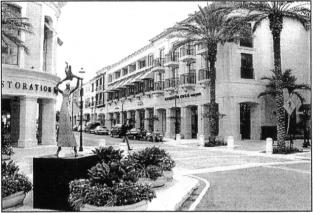
B. Public Open Space/Plazas/Courtyards.
1. Plazas and courtyards should have a visual focal point that draws attention, connects visitors and further enhances the sense of place. The amenity might be a sculpture, fountain, historical reference, public art display, or entertainment.
2. Plazas and courtyards are encouraged where high levels of pedestrian activity are expected, such as adjacent to major entrances and food services such as delis, restaurants, coffee shops and bakeries.
C. Parking.
1. Ground-floor street frontages of parking structures should be devoted to retail uses, particularly adjacent to plazas and public walkways.
2. The facade of the parking structure shall contain building materials and design features that reflect those of the surrounding buildings.
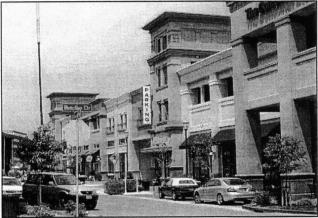 D. Loading and Storage Areas.
D. Loading and Storage Areas.
1. Loading docks, and storage areas shall be located at the rear of buildings or within a parking structure to minimize noise impacts to residents.
2. If views of loading docks and storage areas are possible from public streets, connecting walkways, or residences, they shall be screened through the use of walls, trellises, tall landscaping, or equivalent features.
E. Trash Collection Areas.
1. Trash enclosures shall be located away from residential uses to minimize impacts from noise and odors.
2. Trash enclosures and equipment shall be located so it is easily accessed by service vehicles yet screened from view of public streets, open spaces and pedestrians.
3. Locate trash enclosures and equipment within a parking structure, at the rear of a structure, and within a screened enclosure.
4. Trash collection areas shall be designed to reflect the architectural style of the project and use similar, high-quality materials.
F. Architectural Considerations.
1. A consistent architectural style shall be used for a building and the elements that relate to it, such as trellises, planters, or light standards.
2. Roof lines shall be of interesting and varied shapes, featuring parapets, occasional towers, and gables rather than flat, horizontal lines.
3. Richly articulated facades, including bays, gables, balconies, varied fenestration and color reduce the scale of larger buildings, add visual interest, and relate directly to the pedestrian environment.
4. No building wall should have a blank, uninterrupted length exceeding 20 feet without including one of the following: change in texture, change in plane (two-foot minimum), window (excluding clerestory windows and glass blocks), public art, lattice, tree or equivalent element.
5. Special materials, such as ceramic tile, granite and marble, are encouraged on the base of buildings that face streets or connecting walkways, especially adjacent to major entries.
6. Varied use of building colors should be used to highlight unique design features and building entries and to provide visual interest.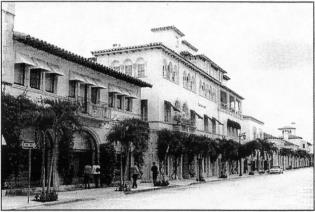
ILLUSTRATIVE 1
|
|
Angled corner treatment, rounded corner feature, and increased height crate a distinct entry statement and landmark at the intersection. Cornices and varied roof height and treatment give a finished appearance to buildings. |
|
|
|
The attention to the architectural details above the ground floor provides continuity throughout the project and provides animation and interest to the ground floor. |
|
|
|
Large ground floor windows invite use and add interest for the pedestrian and contribute to a sense of security. Numerous entries add vitality to the street. |
|
|
|
The rich architectural detailing of contemporary buildings contains historical references that convey a sense of place. Detailed facade treatment, windows, bays and piers, reduces the scale of large buildings. This has special significance in picking up the old town theme. |
|
|
|
Street trees and shrubs provide shade, help define the project, but still allow views of the stores and signs. The mid-height spaces should be kept clear to facilitate visibility. |
ILLUSTRATIVE 2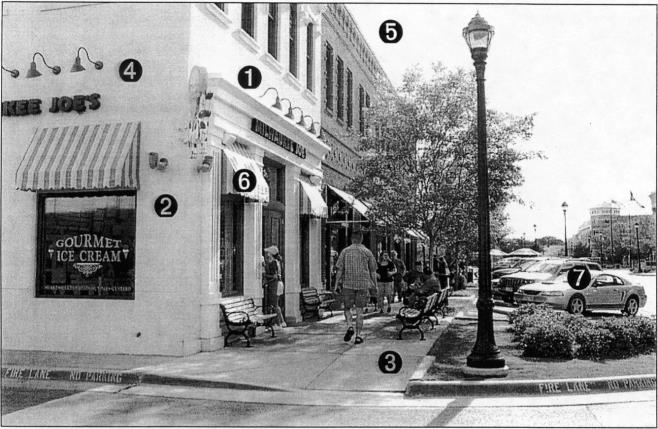
|
|
Unique facades create a distinctive street scene, help identify individual storefronts, and clearly identify entrances. |
|
|
Wall signs and window signs complement the style and character of the building, clearly identify the intended message, and are oriented to the pedestrian. |
|
|
Movable outdoor seating improves the pedestrian experience and enriches the street scene. |
|
|
Lighting is distinctive and conforms to the character and style of the building. |
|
|
Similar, yet distinctive, materials and treatment help buildings work together as a coherent whole, yet provides variation between the different aspects of a project. A detailed cornice, or top, frames the building and provides a distinctive edge. |
|
|
Awnings provide color, shade and store identification and are a distinctive element along the streetscape. |
|
|
Angled parking offers convenience and slows down traffic. |
ILLUSTRATIVE 3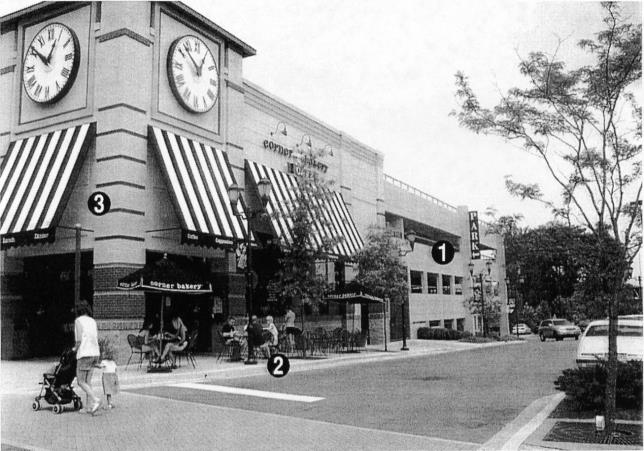
|
|
Parking structures located buildings, in alleys, or on side streets directly behind retail or office uses provide convenient access and preserve the pedestrian street scene. |
|
|
Outdoor dining and movable seating provide excitement in the street scene and improve the pedestrian experience. |
|
|
Corner buildings allow for wrap-around retail uses, which provide more retail exposure and visual interest, and allow for distinctive treatments, such as this clock tower. |
(Ord. 307 § 30, 2006)



